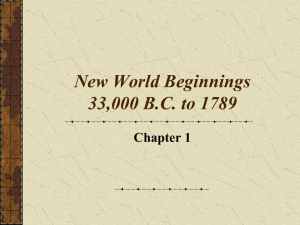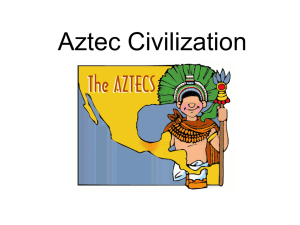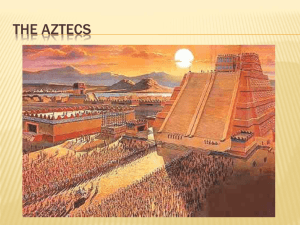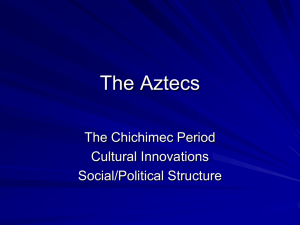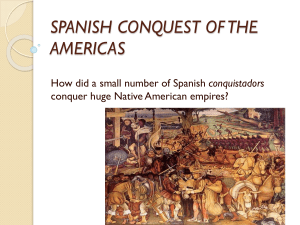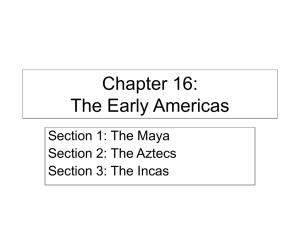The Aztecs
advertisement
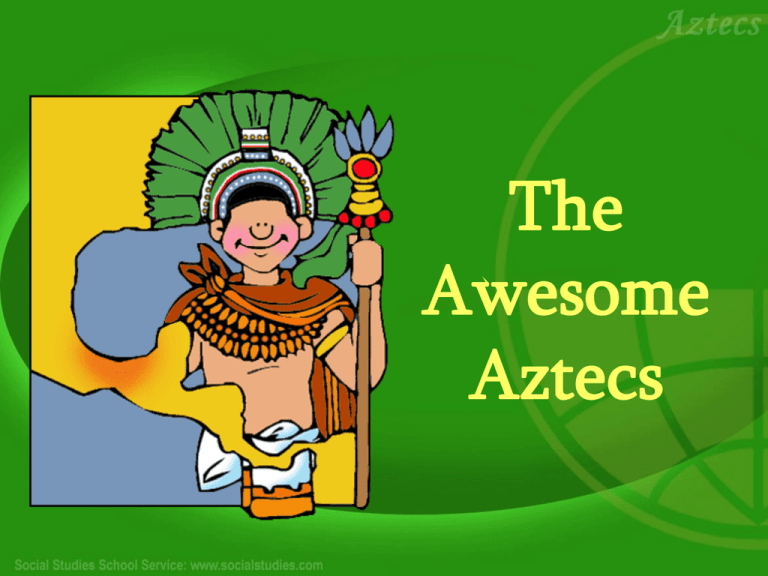
The Awesome Aztecs Introduction The Aztec tribe lived in ancient Mexico for about 400 years. For the first 200 years, the Aztecs were constantly on the move. No one wanted the Aztecs as neighbors. The Aztecs practiced human sacrifice. They believed that if their gods were not fed, they would not do their jobs. The sun god would not bring up the sun, and everyone would die. Introduction To keep their gods happy, the Aztecs believed that human sacrifice was necessary. They used people to feed their hungry gods. Some of the people they sacrificed were Aztecs. However, most of the people they sacrificed were captured from neighboring tribes. This did not make them popular with their neighbors. Sooner or later, their neighbors would band together to chase the Aztecs away. Settlement When the Aztecs first arrived in the Valley of Mexico, other tribes were already living on the best land in the area. This time, rather than fight for the best land or for captives to feed their hungry gods, the Aztecs quietly settled along the swampy shores of Lake Texcoco. They built canoes so they could fish, hunt waterfowl, and trade with other tribes for the building materials they needed. Free School for Everyone To build the city they wanted, they knew that they would need many engineers, builders, and traders. This required an educated population. To solve this problem, the Aztecs set up a system of public schools. Attendance was mandatory for all Aztec children, even girls and slaves. The Aztecs were the only people up to that time in history to have free schools that every child had to attend. All-Girls School There were three different schools: one for girls, and two for boys. Girls learned about religion and were trained to be good wives and mothers. They learned how to cook, sew, and how to care for their children. They also learned how to make beautiful woven textiles. Sons of the Upper Class Sons of the upper class went to the nobles’ school. Sons of wealthy traders and merchants also went to this school. They studied law, writing (hieroglyphics), medicine, engineering and building, interpretation of dreams and omens, and self-expression. They also learned about their history and religious beliefs. It was a tough school. The boys were humiliated and tormented to toughen them up. Sons of Commoners and Slaves The other boys’ school was for sons of commoners. Its main goal was to train warriors and farmers. Boys had to sleep under skimpy blankets. They were given hard bread to eat. The commoners’ school also taught history, religion, manners, correct behavior, and important rituals, along with singing and dancing. Specialized Professions No matter which school an Aztec boy attended, he was trained to be a specialist. Boys studied how to be farmers, traders, engineers, builders, astronomers, and doctors. Students who became builders and engineers designed and built the amazing Aztec cities, including the capital city of Tenochtitlan, located on the swampy shores of Lake Texcoco. Floating Gardens As the Aztec population grew, more food was needed. To solve this problem, Aztec engineers created “floating” gardens. They built a series of rafts, which they anchored to the lake bed. They piled on dirt and grew crops. They made walkways out of mud and reeds to connect the floating rafts. The gardens were quite successful. The Aztecs grew chili peppers, squash, corn, tomatoes, and beans. Tenochtitlan Thanks to Aztec schools, which produced trained engineers, builders, and traders, the Aztec capital of Tenochtitlan became a great city. It had huge temples, beautiful open plazas, and a large central marketplace. Tenochtitlan By the mid-1400s,Tenochtitlan was one of the largest cities in the world. It had a population of over 200,000 people. Professions Questions 1. What purpose was served by having every Aztec child—including boys, girls, and slaves— attend school? 2. What is a specialized profession? Expansion Around 1400 CE, the Aztecs began to conquer neighboring tribes. Since the Aztec population had increased, they needed more land for farming and for building cities to feed and house their growing population. They needed more captives to feed their hungry gods. Schools needed to be run. Storehouses needed to be filled. Temples needed to be built. The Aztec government had its hands full trying to satisfy all these needs. Tribute War was the answer. When the Aztecs conquered a tribe, they demanded to be paid tribute in the form of food, clothing, precious stones, building supplies, and captives. The Aztecs would keep the first four for themselves, but the last they would give to their gods. Other tribes hated and feared the Aztecs. Sometimes, they simply ran away from the Aztecs, rather than fight. The Emperor The Aztecs had an emperor, a king who ruled over all the people. The emperor lived in the imperial palace in the capital city of Tenochtitlan. The palace was huge. It even had its own zoo. The ground floor of the palace housed government offices and the shops of the most talented craftsman in the Aztec empire. City-States As the Aztec empire grew, government officials directed Aztec engineers to build many fine cities. A noble family controlled each city. Although the noble families were supposed to assist the emperor, the truth is that each family pretty much ran things in its city the way it wanted. Thus, the Aztecs, like the Maya, were governed as a group of city-states. Crime & Punishment Aztec rulers were quite severe. Judges decided on the punishment for those who broke the law. Drunkenness was the worst crime: the punishment for being drunk was death. Thieves were also put to death. Laws were tough, and they were written down. Holy writings called “codices” detailed the punishment for each crime. There was no mercy. If you broke the law, you paid the price. The One-Time Forgiveness Law There was one exception: the one-time forgiveness law. Once in your lifetime, you could confess your crime to the priests and be forgiven. However, you had to confess before you were caught. If you committed any other crime after that, you would be punished to the fullest extent of the law. Aztec laws and punishments were very harsh. Government Question Despite there being an all-powerful emperor, why were the Aztecs actually governed as a group of city-states? Homes The poor: Homes of farmers and other commoners were huts with thatched roofs. Furniture was limited. They had blankets for sleeping and pottery for cooking. Each home had a garden. The rich: Homes of the wealthy were made of sun-dried brick, whitewashed to look clean. Each home had a separate room for steam bathing, where water was poured over heated stones. Clothing In the Aztec civilization, class structure was very important. Upper class: People in the upper class wore clothing decorated with feathers and embroidery to show their status. They also carried fans made of feathers. Common people: It was against the law for commoners to wear feathers or to carry fans. If commoners broke these laws, they were killed. Marriage Many wives: At about age 20, men married women who were 14 or 15 years old. A man could have more than one wife as long as he could support them. Matchmakers: Weddings were arranged by a matchmaker, usually an old women who used omens and charms to match up the right bride and groom. Wedding party: The bride’s family threw a party over the three or four days before the wedding. Marriage Tying the knot: On the day of the wedding, the bride rode to her new home on the matchmaker’s back. There, the bride and groom stood before the hearth (the fireplace) wearing special coats, which were then tied together. From that point on, they were married. New babies: The Aztecs welcomed all life. The birth of a boy or a girl was celebrated. This was true for both nobles and commoners. Correct Behavior The Aztecs were very concerned that all their citizens behave correctly. The rules of correct behavior were written down. These were not just guidelines, but actual laws. Should you break the law, you could be killed. Children learned the laws of correct behavior in school. The Aztecs had a code of behavior for everything. Correct Behavior Here are some of the rules of behavior: • Do not mock the sick • Do not mock one who has sinned • Do not set a bad example • Do not interrupt the speech of another • Do not make ugly faces • Walk with a peaceful air • Do not complain Slaves Aztec nobles kept slaves. Slaves were not captives from other tribes, they were Aztecs. There were only two ways a person could become a slave: either as punishment for a crime, or being voluntarily sold into slavery. A slave’s life was much the same as the life of a free person. Slaves could marry other slaves and even freewomen. Children of slaves were not slaves themselves—one could not be born into slavery in the Aztec world. Slaves It was difficult to get rid of a slave once purchased. If a slave refused to obey, the owner had to bring the slave to a plaza. In front of witnesses, the owner had to prove that the slave would not obey. This had to be done on three separate occasions, documenting three different acts of refusal. After the third time, the owner could bring the slave back to the market to be resold. Slaves Slaves could buy their freedom. All they needed was enough money to pay back whatever the owner had paid to buy them. A slave could earn his or her freedom. On the way to the slave market, if a slave got away and managed to run to the palace without being stopped, that slave was immediately free. The only person who could chase that slave was the master’s son. If anyone interfered with the race, that person became a slave. Recreation Poetry: For all their love of war, the Aztecs did have a softer side. They loved to write and to read poetry. Much of their poetry was about heroic acts of war, love, or religion. Games: The Aztecs loved games. They loved to give people a sporting chance. Some of the games they played included a ball game similar to one played by the ancient Maya. Aztec Ball Games Ballplayers: One of the most highly admired professions in the Aztec world was that of ballplayer. The Aztecs, like the Maya, had huge ball courts. The Aztec ball game was a very rough sport. The best ballplayers were treated like superstars. Daily Life Questions 1. What did rich people carry to show their status? 2. What was one of the many rules of good behavior? • How could slaves regain their freedom? Spanish Arrival A few years after Columbus discovered America, another explorer, Hernan Cortes, landed in what is now Mexico. The Spanish were looking for lands to conquer, gold to capture, and people to convert to the Catholic religion. Normally, the Aztecs would have killed the invaders immediately. However, they believed Cortes was a god in disguise. An old legend had foretold that this would happen, so they welcomed the Spanish into their city. Spanish Arrival The Spanish were amazed at the beautiful capital city of Tenochtitlan. Everything was clean. There were hairdressers and “eating houses.” Even commoners could buy medicines, herbs, meat, pottery, jewelry, and household goods. The marketplace held more than 60,000 people. No one used money; goods were bartered and small differences in value were evened up using cocoa beans. Spanish Arrival The Spanish conquered the Aztecs in two years and occupied the country. The Spanish did not conquer the Aztecs with guns alone; they also used horses and dogs. The Spanish brought huge fierce mastiffs to go into battle. Disease also helped to bring down the Aztecs, who had never been exposed to anything like smallpox. Spanish Arrival The Spanish also had help from the other tribes in the area. These tribes saw a chance to not only get even, but to actually get rid of the hated Aztecs. By the mid-1500s, the Aztec empire had collapsed. Today, around 1,000,000 descendants of the ancient Aztecs live in Mexico. While human sacrifice is, of course, no longer part of their festivals, the art and the many games the Aztecs enjoyed live on. Spanish Arrival Questions 1. What was the name of the Spanish leader? 2. Why did other tribes in the area help the Spanish to defeat the Aztecs? Inventions/ Achievements To name a few: • Floating gardens • Written language of hieroglyphics • Written laws • Free, mandatory education • Specialized professions • Woven fabrics • Aztec ball games • Poetry • Engineering and medicine


